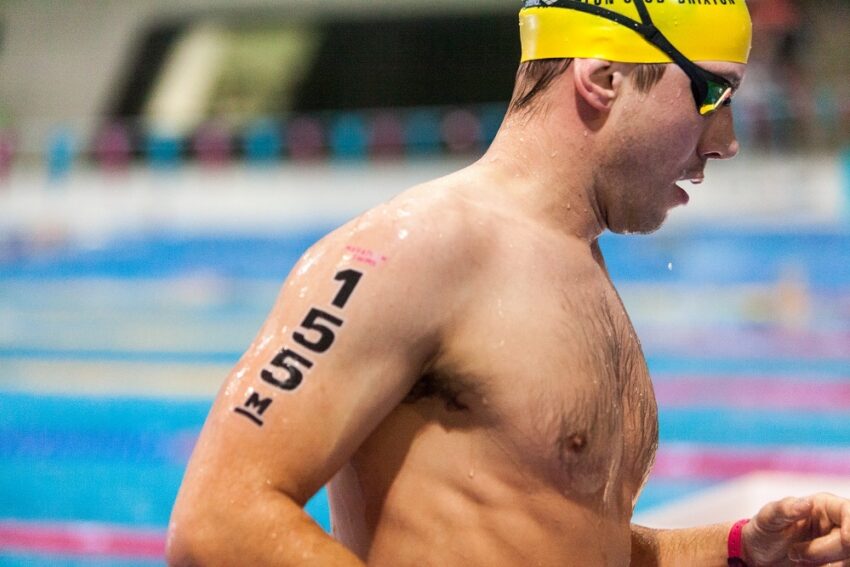How to swim 10km with Marathon Swims
Last November I completed a 10km pool swim with Marathon Swims at the London Aquatics Centre. The event has a novel format that makes it a fun challenge for both pool and open water swimmers.
It works as follows: Starting in the bottom right hand corner of the pool, swim two lengths in lane 1, always keeping to the right. At the end of the second length, duck under the lane rope and do the same thing in lane 2. Repeat until you’ve done two lengths in each of the 10 lanes, bringing you to the bottom left end of the pool, for a total of 1km. Exit the pool, walk or jog back to the start, repeat nine more times.
This makes it quite different from either a continuous 10km in open water or any standard indoor pool race, and it therefore warrants a different approach to either. There is no mass start. The event is chipped time, with every swimmer starting individually in time trial format. This means you can’t save energy by drafting another swimmer as you might do in open water nor can you take pace cues from other swimmers like you might do in a pool race. And while the organiser attempts to allocate swimmers to waves and start times based on their speed, there’s no getting away from sharing the water with people swimming at a different pace to you. You will almost certainly be overtaking (or overtaken by) other swimmers frequently. Unlike a regular pool race, you don’t get a lane to yourself. The short walk or jog section between each kilometre also adds an interesting dynamic.
So, what’s the best way to swim it? Here are my thoughts:
- Make a plan in advance that includes a kit list and what you want to eat and drink before, during and after the swim. Get everything ready the day before. Pack spare goggles.
- Get to the venue in good time. I planned to arrive 90 minutes in advance of my start time, which was lucky as transport problems delayed me by an hour. I would have been panicking if I hadn’t allowed for some contingency.
- The only option for an in-water warm up at Marathon Swim is to buy a public swim session ticket for the training pool. I don’t think it’s worth the effort. Do a brief land-based warm up instead.
- After changing, place any food or drink you’re going to need during the swim on the table next to the transition area. It’s good if you have an easy-to-find distinctive bottle. I also left my spare goggles here, in case I needed to switch at some point. Remember where you’ve put your stuff!
- Start slowly. A quick look at the results shows most people getting progressively slower with each km but the faster swimmers tended to be more consistent. A slower start should help you to maintain pace later on.
- Swim as close to the lane rope as you can to reduce the risk of being hit by anyone coming in the opposite direction, especially if they are overtaking someone else and swimming down the middle.
- If you’re overtaking anyone, be considerate. They might be a nervous swimmer. And look up first to make sure you’ve got enough space to get past safely.
- Tumble turns make switching lanes and ducking under the lane rope easy, but it might be worth practising first if you haven’t tried this before. Also, always make sure you have enough space to tumble. If there is congestion at the end of the lane, a grab turn will be safer (and also gives you the opportunity to thank anyone who might be letting you overtake at that point).
- If you’re doing grab turns when switching lanes, sink deeper than usual before pushing off, and maintain your glide long enough to ensure you don’t hit the lane rope.
- At the end of each kilometre, I’d recommend a brisk walk or slow jog through transition rather than an all-out sprint*. You won’t gain more than a couple of seconds by sprinting but you will elevate your heart rate unnecessarily.
- If you’re stopping for a drink or snack, divert to the food table, take what you need quickly and get on with the swimming. You shouldn’t need more than 30 to 45s, even with a food break. See below for my nutrition strategy.
- In theory, you shouldn’t need to count your kilometres as there is a live tracking screen that shows you how far you’ve swum. However, mine showed 7 when I’d done 9, so it’s best to keep track yourself.
- When you finish, have a shower, stretch and eat some good quality food as soon as you can.
- Remember, you’ve swum a marathon, so be kind to yourself afterwards, celebrate and allow yourself time to recover.
*There are, naturally, alternative strategies. We can see from the results that some swimmers took breaks of several minutes between each kilometre.

The transition at the end of each kilometre adds an interesting dynamic
My nutrition strategy
I followed the following approach to my nutrition for the 10km swim.
4 hours before start: early carbohydrate-lunch (baked potato and beans)
90 minutes before start: flapjack
Final hour: about 250ml of water in occasional sips.
During swim
- After 3km: energy gel + water
- After 5km: energy gel + water
- After 7km: energy gel + water
- After 9km: mouthful of energy drink
In reserve: energy bar (in case I felt the need for solid food) and energy drink (sometimes easier to stomach than gels)
Post swim: pasta-based dinner with vegetables and salad








